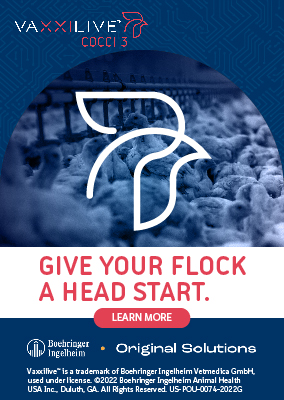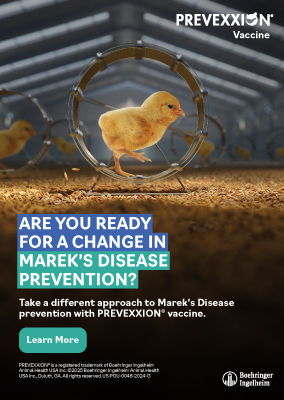As disease pressure and performance demands increase across the poultry sector, data is playing a growing role in helping producers manage risk, optimize health and justify production decisions.
From digitizing information to store it securely to using it to guide real-time decision-making, for Dan Wilson, DVM, founder of Wilson Veterinary Co., it has become integral to the way he works with producers to improve flock performance.
“We’ve always collected data,” he said. “But storing it in a way that lets us access it and use it over time is what’s made the difference.”
Wilson’s decision to embrace digital data came after a flood in his basement destroyed 40 years’ worth of diagnostics stored in files.
“I learned my lesson the hard way; my first five years of work, including decades of reports from some farms, were gone,” he said. “That was my main trigger for moving to digital posting notes and lab records.”
When it came to setting up his own practice a few years later, he implemented a centralized system that collects and interprets diagnostic data from post-mortems, serology and performance metrics.
Using information collected across the entire production cycle, from hatchery to pullets to layers, enables him to give producers a clear picture of what’s happening in their flock.
Routine data, real-time insights
“People have looked at serology data for years, but the bigger transition – and the more helpful data we collect – is the posting data,” Wilson explained.
He and his team gather detailed scores for up to 15 parameters per bird, compiled across multiple houses and farms. “Whether we’re looking at mortality on the farms or scoring at a posting session, that data quickly adds up.”
With a robust dataset at his fingertips, Wilson can closely monitor trends in skeletal health, immune response and nutritional condition. These metrics can then feed directly into nutrition and management strategies.
“What’s helpful is we can pull up scoring data to show how things have changed over time,” he said. “I’ll say, ‘Remember 3 months ago when we talked about this? Here’s what’s changed.’
“You can’t argue with data on a graph when you have concrete scoring over time – especially if you have other data or global reference points for comparison.”
Immune monitoring
Bursa and thymus scoring is another element that is important for guiding management decisions, particularly for younger birds.
“Bursa and thymus development correlate strongly with future performance – if those regress too early, we start asking hard questions about immunosuppression, whether it’s from chicken anemia virus, infectious bursal disease or even poor early management.”
Although serology remains a common tool in poultry health programs, Wilson’s team has developed a more structured way of storing and interpreting results. Their custom database captures antibody titers from over 70,000 diagnostic tests each year, sorted by age, geography and disease type.
“If a flock’s antibody levels spike right after a drop in egg production, that tells us something,” he said. “You need that ammo to take to leadership when you want to change a vaccine protocol or push for more training.”
Visualizing data
For Wilson’s team, visualizing data is essential – not just for their own analysis, but for communicating with farm staff across all levels.
“In the best scenario, you finish a posting session and can turn your device around and show the trends,” he said.
“Historically, vets would say, ‘Here are two numbers, it went up 4000.’ But if you show them visually, they go, ‘Oh, absolutely. We’ve got to work on that.’”
He also uses visual data to track longer-term improvements, particularly in muscle, bone and fat condition, where many layer companies have made significant improvements. “Sometimes it’s a nice way to celebrate successes,” he added.
Balancing costs
Collecting and analyzing diagnostic data comes at a cost, but Wilson believes the return on investment is clear when that information is used to support long-term decision-making.
“If you’re already spending $100 a round on serology, and those PDFs just go in a drawer, you’re wasting that money,” he said. “Why not store it in a database where you can see long-term trends?”
Linking health data to production issues, such as egg drop, mortality or egg quality, helps justify changes to vaccines, nutrition or management.
“If you don’t have information to back what you’re saying, it’s a lot harder to get buy-in,” he said.
He acknowledges that cost can be harder to justify when diagnostics show no problems.
“People say, ‘What a waste of money – you just told me everything looks great,’” he said. “But knowing what it isn’t is just as important.”
In his experience, producers are more likely to invest when they can see how others are using the same tools.
“Once you have a couple of wins and show how it works, it’s easy to convince people it’s more valuable that way.”
Lessons from the field
In his own practice, Wilson has seen how data has been valuable in picking up on hidden problems, particularly in cage-free systems.
“Fat condition with cage-free layers is a struggle right now, and when fat condition goes down, we typically see production drops later, or cumulative egg numbers declining in those flocks,” he said.
“It’s been really helpful to show people visually that over time, you start with good fat conditions, and once they drop, that impacts productivity.”
In other cases, regular Mycoplasma gallisepticum (MG ) serology has revealed antibody fluctuations linked to seasonal ventilation changes. Where the issue would have previously gone unnoticed, Wilson has been able to show a clear pattern.
“Before, everyone would have just said, ‘Hey, they’re MG positive. Forget about it.’ Now, with the dashboard showing information over time, we can correlate it with production data and show them that this is worth fixing.”
The role of AI
As data volumes increase, Wilson sees a growing role for artificial intelligence in helping interpret trends, particularly in areas where human judgment can be inconsistent.
Interpretations often vary between veterinarians – what’s significant to one might be irrelevant to another. AI could help bring objectivity to those decisions, he said.
“If an AI tool can say, ‘Yes, this titer increased, but based on all available data that’s a negligible increase,’ that’s better than a subjective interpretation,” he added. “I appreciate AI running mathematics that my head can’t do.”
But he’s clear that AI is only as useful as the data feeding it. “Even now, we have to manually export spreadsheets to compare health and production data,” he said. “A lot of companies talk about integration, but it never quite gets there.”
His advice for producers or veterinarians unsure about diving into data is simple: start small and build.
“Whether it’s upgrading production software, digitizing records or adding post-mortem scoring, every improvement matters,” he said.
“It’s not just about troubleshooting. It’s about building a long-term understanding of bird health that stands up to scrutiny, year after year.”






